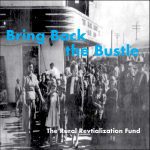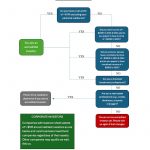
The technocrats are coming to your rural town to operate the AI data center that is under construction. We, at The Rural Fund, aim to make that a good thing.
Hi, welcome to Bring Back the Bustle, a podcast about revitalizing rural America. I’m Shavon Jones, your host. Today, the topic is class, socio-economic class. How to appeal to and mesh economically mixed groups within a single, small community.
The premise for this discussion is the fact that AI Data Centers are poised to become anchor businesses that can revive rural communities left destitute when manufacturing plants exited in search of cheaper labor abroad.
There’s a good way and a bad way of introducing city slickers into rural America. The good way revives the region, redevelops downtown districts, and brings renewed energy, optimism, and economic stability for all.
The bad way results in two cities of haves and have nots living a stone’s throw away from each other. You may remember John Singleton’s movie Higher Learning. If not, it’s a good watch. You can download or stream it. It’s about a college in the middle of a community of poorly-educated people. It’s an example of resentment and uneasy relations between the two populations.
No one would design a community that way on purpose. But a lack of planning will lead to that result almost as easily as if it had been intended. So this episode is about assimilating Technocrats into rural communities.
Assimilation Is a Two-Way Street
Assimilation works both ways: the natives give a little and the transplants make an even bigger adjustment. This topic of rural life will cover assimilation from both points of view. First, we’ll look at it from the viewpoint of the existing residents who’ve been living a certain way (good or bad, and actually it’s good and bad) for a long time, and all of a sudden, the Technocrats are coming and bring uncertainty and change.
Then, we’ll look at assimilation from the viewpoint of transplanted worker moving to the boondocks. In some ways, moving from San Francisco or Seattle to a rural community hundreds of miles from a metropolis is even more different than moving from San Francisco to a foreign city like Paris or Rio de Janeiro. There’s a language barrier and a lifestyle barrier that is just as pronounced. The TV show Green Acres was before my time, but I get the premise. You’re talking about people who are as different as night and day. But, you’re beginning a marriage, and you have to make it work. It’s a story of compromise and measured change.
Notice I ended both of those points of view with the word change. That was purposeful because assimilation is about change.
Change Can Be Unsettling
When a new company comes to town, the locals experience mixed emotions. Some are optimistic that there will be more money and opportunity. Those are usually young people who are college educated or college bound. Property and small business owners are other groups who see opportunity in the introduction of new community members to rent or buy from them. But many people are afraid of change and of getting left out or left behind when the opportunities are made available. They fear that whatever good things are coming aren’t intended for them. The new jobs are not something they can do. The new activities aren’t something they can afford or are consistent with their interests. They hear about everything through the rumor mill rather than through communication from their elected officials. So they can’t imagine how they fit in and often don’t believe that anyone is thinking about them at all. They are convinced that they are going to remain as invisible as they were before the change occurred.
Almost none, not even the optimistic ones, believe that the newcomers want to be part of their community or their culture. They believe fancy, educated city people look down on them. Some of them look forward to an opportunity to put those uppity people in their place or show you that you’re not better than them and that this is their community where you are just a guest.
There’s Such a Thing as Rural Culture
To mitigate these negative attitudes, it’s important that Technocrats understand rural culture. Culture tends to depend on the region and weather. Small northern and midwestern towns have a culture around family and snow and ice. They ski, ice skate, ice fish, and so own. They drive vehicles that perform well in the snow. They have chains on their tires. They are kind and polite to everyone but aren’t quite as friendly to strangers as Southerners, likely because it’s cold. You don’t have time to stand outside chatting when the tears are freezing on your face. They spend a lot of time inside with their nuclear families, and when they are outside, they are moving around to stay warm or walking quickly to get inside. That’s a very different than Southern rural towns.
Southern culture is incredibly distinct in small towns. It’s about God, country, and sports. Rural southerners are religious. Churches are as common as liquor stores. They fish, hunt, ride ATVs, drive pickup trucks and spin mud everywhere. Southern rurals tend to be neighborly—everyone speaks to everyone, often multiple times each day.
Some rural Southerners occasionally visit fancy cities in the U.S. or take a trip to Europe. They don’t envy it. While a city slicker tends to get melancholy toward the end of a monthlong trip aboard, after a week, the typical Southerner is tired of all the hooey and just wants to get back home. In a sense, rural Southerners cling to their guns and their religion as one of our former presidents so aptly pointed out.
In both the rural North and the rural South, there may not be a huge arts scene for a number of reasons. Lack of a community to financially support the arts is likely at the top of the list. Next on the list is a different view of what constitutes art. As you can surmise, one of those reasons is easy to fix—the money issue. The other not so much. One of you has an oil painting over the fireplace. The other has taxidermy.
There also aren’t a lot of finicky eaters: vegans or vegetarians in rural America. Rural people often eat off the land, so it’s a protein-heavy diet. They didn’t just kill that buck to make taxidermy art; they ate it.
So, if you’re an atheist who plays video games instead of going outside and getting dirty and the only time you eat animal flesh is at a sushi restaurant, you’re in for a culture shock when you move to rural America.
The Cost of Living
Another way change can be upsetting when technocrats come to town is with respect to the cost of living. Because wages are lower in rural America, things cost less. As business people, we get that. We understand that you have to price your product to move. So nearly everything is priced affordably in rural towns. Housing costs, restaurant meals, clothing, gasoline, personal labor to mow the lawn or wash the car.
Of course, what’s “affordable” to a city slicker is different from what is affordable to locals living on fixed incomes. I was visiting my mother after her surgery last winter. I took my car because I didn’t want to hear her mouth about my driving her car too much. My mother has a guy from the neighborhood wash her car from time to time. So, I asked him to wash mine and paid him $20. I felt like I’d gotten a steal because I pay $35 in Miami. My mom got upset because the locals usually paid $10 and I’d come in and driven up the price of a car wash. So, the next time I got my car washed I negotiated to get down to $15. That’s is now the new price. I single handedly increased the price of a car wash by 50% from $10 to $15.
That’s not a huge problem for the locals because having someone else hand wash your car is a luxury. But what about when you drive up the price of rental housing by 50 or 60% the way the data center construction workers have done. Housing is a necessity. Before I end this episode, I’m going to suggest ways to address the cost of living problem created when technocrats relocate to rural communities. But first, let me introduce technocrats to some of the hiccups of rural life.
What Does Rural Life Look Like for Technocrats Moving In?
In a nutshell, normal conveniences are missing, and it’s unspeakably boring in rural America, especially at night. Case in point, I’m a Miamian for more than 20 years now. I take for granted more than just our beautiful beaches. I’m accustomed to having anything I want within a few miles of home. Even the lack of highbrow cultural experiences in Miami has largely been remedied since the New Yorkers came to town and set up permanent residence during the pandemic. So I don’t even have to leave time to catch a show or see an exhibit anymore.
But in my mom’s small town (which is near an AI data center currently under construction), the lack of basic conveniences is palpable. There isn’t an epicurean market for 100 miles. I remember craving mushroom risotto. The only mushroom I could find was baby bellas. No oyster, shiitake, trumpet. I couldn’t even find chanterelles in the fricking woods. The dish came out one dimensional. My craving for churrasco also went unsatisfied. Skirt steak is not a cut that is stocked locally. Fresh herbs for a chimichurri sauce were also oddly unavailable in a region of numerous farms. I longed for home.
There was nothing to keep me distracted from the annoying inconveniences. There is no movie theater, no spa, no health club, no bowling alley, no sports bar, no skating rink, no arcade, no museum, no pool hall or billiards room. There are no music venues, night clubs, or comedy clubs. The only indoor entertainment is a vice, gambling, which, noticeably, is contrary to the God, country, sports local culture.
The gambling shacks are exactly what should not be in rural America because all they do is take. You have to pay for drinks even as you’re gambling away your paycheck. Gambling shack ATM fees are as much as $6 to get money that locals really can’t afford to spend. Moreover, only a couple of low paying part-time jobs are created by a gambling shack.
What Technocrats Can Do to Support Their New Community
There are things that can be done to build better rural communities. As a low hanging fruit since it’s easy to do, technocrats throw consistent work and business to the locals to help them adjust.
- You need to buy (and over pay for) laundry service, housekeeping service, catering service, lawn service, handyman services, and yes, car washing services, from the locals so they can stay afloat during a period of rapid change.
- Shop at mom and pop stores rather than ordering from Amazon or going to the local Walmart.
- Things that you’d normally do online, such as buying home or car insurance, are still done through local agents in rural towns. The price of the policy is the same. You just have a personal contact to help if something bad happens. So, you get more for your money.
Partial Integration
There is something investors and data center owners can do as well. We can develop a variety of facilities and position them in central locations rather than building right around the data center and focusing solely on facilities intended for the technocrats. And we can support the public school system even if our children aren’t going to attend public school. Let me talk about those two points in more detail.
The community needs to be integrated in some ways. People from different classes and or backgrounds should see each other more places than church. You need to get a beer at the same bars. Be in the same audience to watch a musical act. Have Sunday brunch at the same hotel restaurant. While there will be some facilities that different groups aren’t interested in or cannot afford, there also must be some common experiences.
That common experience was once provided by the former Friday Night Lights culture, where everyone in town went to the high school football game. That anchored rural social life from the 1980s through the 2000s. That culture is being decimated by laws that shift public education funding to charter and private schools.
If communities abandon the public school system, we will create that Higher Learning tension beginning much earlier than college. If you place your kids in private school, you need to pay for it yourself or make a donation toward public school extra-curricular activities or books and materials.
The stakes are high. If we get community development right we’ll create thriving economically mixed rural communities similar to what exists in large cities that merge different classes of people all serving and engaging with one another. But if we get it wrong, we’ll create re-segregation.
How the Rural Fund Serves Rural Communities
Here, at the Rural Fund, we are focused on servicing economically diverse communities as well as on creating permanent jobs that pay a living wage so our workers can transact business with their neighbors—keeping the money in the community. We understand that the more customers we have, the more money we will earn. Rural communities already have low populations. So, creating businesses that serve only a small subset of the community can be a recipe for unprofitability.
We look at rural markets the way the fashion industry looks at the clothing market. A brand like Ralph Lauren makes high end offerings sold in private boutiques and better department stores. It also makes lower cost items available in discount stores like Macy’s and TJ Maxx. Even ultra exclusive brands like Balmain will offer a $5,000 blazer alongside a $200 T-shirt. They don’t leave money on the table. The allow the customer to start at an entry level and grow with the brand.
For us, we might have a restaurant that offers a $50 weekend brunch for our more well-heeled customers while serving a $12 American breakfast every other day of the week, ensuring that we meet the customer where they are. And, by the way, everyone likes to save money. That weekend brunch customer will also buy the $12 breakfast during the week, making our restaurant an integrated venue, and hopefully, a community hot spot.
I invite you to visit our website (www.ruralqrof.com) to read more about how we how we help data center owners assimilate their workforce into rural communities and enjoy a positive employee experience. I’m Shavon Jones. I will be here again next week talking about rural revitalization. I’m looking forward to it, and I hope you are too.



No responses yet